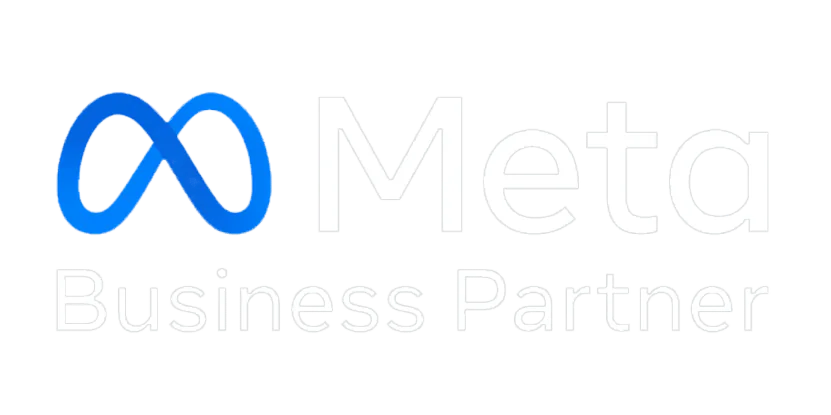Why Every D2C Brand Needs a Chatbot for WhatsApp in 2025
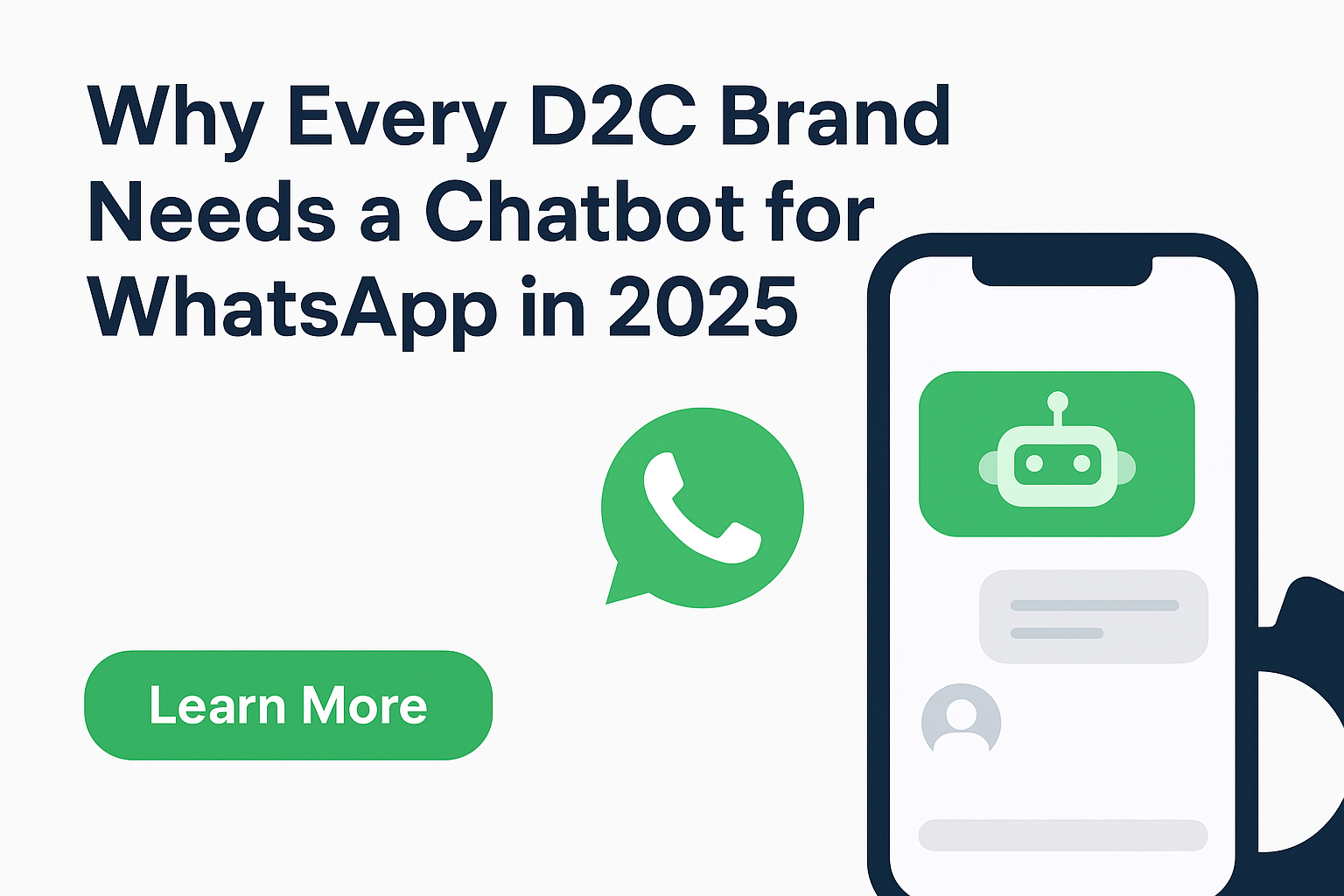
Introduction In the fast-moving world of direct-to-consumer (D2C) brands, customer expectations have never been higher. Shoppers expect rapid responses, seamless checkout, and personalized service—all the time. Enter the WhatsApp chatbot: a tool that delivers real-time engagement, automates routine tasks, and scales your support and sales channels. In 2025, having a strong chatbot for WhatsApp is no longer a luxury—it’s a necessity. This post explores why every D2C brand should adopt a WhatsApp chatbot this year, the benefits, best practices, and how to get started. What Is a WhatsApp Chatbot A WhatsApp chatbot is an automated messaging solution integrated with WhatsApp (often via the WhatsApp Business API) that can respond to customers, guide them through workflows, share product catalogs, process certain requests, and even facilitate purchases. Unlike manual support, where human agents must respond each time, the chatbot can handle routine interactions, FAQs, order updates, abandoned cart reminders, etc., freeing human time for higher-complexity or high-value tasks. Best Practices for D2C Brands Using WhatsApp Chatbots Challenges & Things to Watch Out How to Get Started with a WhatsApp Chatbot for Your D2C Brand Also, check out this detailed look at WhatsApp chatbot message automation to deepen your strategy: WhatsApp chatbot message automation FAQs About WhatsApp Chatbots for D2C Brands Q1. What is a WhatsApp chatbot? A WhatsApp chatbot is an automated conversational tool that interacts with customers on WhatsApp, answering queries, providing updates, and facilitating sales without human intervention. Q2. Why do D2C brands need a chatbot for WhatsApp in 2025? Because consumers demand instant, personalized service. WhatsApp chatbots boost customer satisfaction, reduce costs, and increase conversions—making them essential for D2C success in 2025. Q3. Can a WhatsApp chatbot handle complex customer queries? Yes, but for very complex or emotional issues, a hybrid approach is best: the chatbot handles routine tasks and escalates complex cases to human agents. Q4. Do I need coding skills to set up a WhatsApp chatbot? No. Many platforms allow drag-and-drop chatbot building without coding. Providers like TheBotMode help D2C brands get started quickly. Q5. How much does a WhatsApp chatbot cost? Costs depend on your provider, usage, and message volume. Small brands may start at a low monthly fee, while enterprise plans scale with advanced automation. Q6. Can WhatsApp chatbots help increase sales? Yes. They recover abandoned carts, upsell related products, and personalize offers, often doubling conversion rates compared to traditional channels. Q7. Is a WhatsApp chatbot compliant with WhatsApp rules? Yes—if built via official Business API providers and using approved templates for proactive messages. Compliance ensures uninterrupted service. Conclusion In 2025, a WhatsApp chatbot is more than just an add-on—it’s a core part of what makes D2C brands competitive. From boosting conversions and reducing costs to delivering the kind of customer experience shoppers increasingly expect, there are many compelling reasons to act now.
Why WhatsApp Broadcast Bulk Message Is a Game Changer for D2C Brands
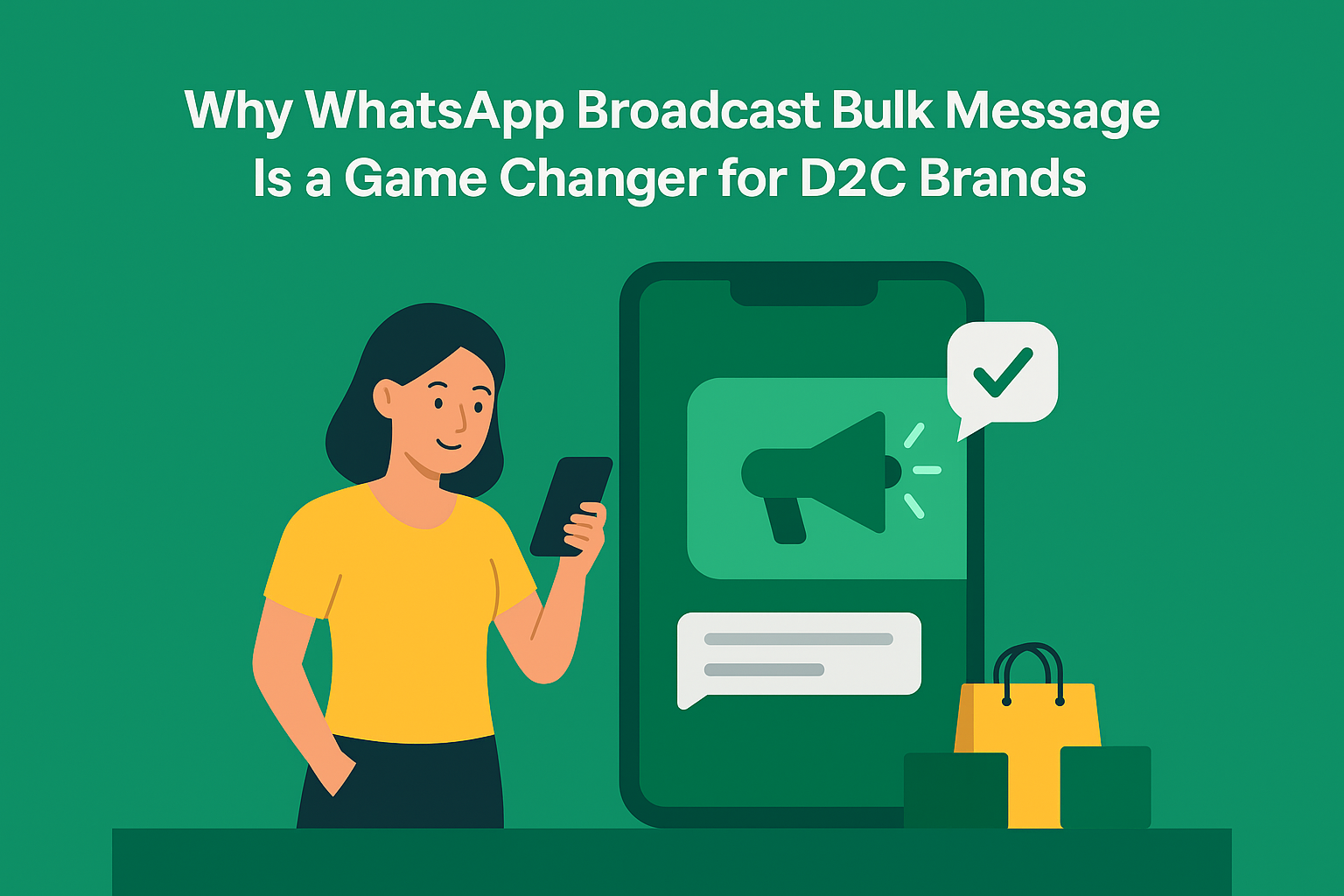
Introduction Direct-to-Consumer (D2C) brands thrive on customer relationships. But with email open rates hovering around 20% and SMS engagement gradually declining, many brands struggle to capture their audience’s attention. Enter WhatsApp broadcast bulk messaging — a tool that combines speed, personalization, and direct engagement. Whether it’s sending WhatsApp broadcast messages for promotions or using broadcast for business to automate updates, the platform has become a must-have for modern D2C marketers. In this blog, we’ll explore why bulk messaging is a game-changer, the benefits for D2C brands, and how to implement it effectively. What Is WhatsApp Broadcast & Bulk Message for Business? A WhatsApp broadcast allows businesses to send one message to multiple recipients at once. Unlike groups, recipients don’t see each other’s replies. For D2C brands, the real power lies in the WhatsApp Business API, which enables bulk messaging at scale with features like: 👉 Learn more in this guide: WhatsApp Broadcast Major Benefits of WhatsApp Broadcast Bulk Message for D2C Brands 1. High Open Rates & Faster Engagement WhatsApp messages enjoy 90%+ open rates, significantly outperforming email and SMS. For D2C brands, that means faster clicks on promotions and immediate responses from customers. 2. Personalization & Segmentation Unlike traditional broadcast tools, WhatsApp allows tailored communication: 3. Abandoned Cart Recovery D2C brands lose millions to abandoned carts. A simple WhatsApp reminder with a product image or discount code often converts better than an email. 4. Cost & Time Efficiency Compared to ad spend on social platforms, bulk WhatsApp broadcasts are affordable. Automation reduces manual work, saving both money and time. 5. Better Customer Experience & Trust Verified business accounts build credibility. Customers feel safe receiving updates like: 6. Improved Loyalty & Repeat Purchases By sending exclusive offers, early access sales, and personalized content, brands can keep customers engaged and drive repeat purchases. Conclusion For D2C brands, WhatsApp broadcast messages aren’t just another channel — they’re a direct bridge to customers’ most active platform. By leveraging WhatsApp broadcast bulk messages strategically — with segmentation, personalization, and automation — brands can boost engagement, recover lost revenue, and build stronger relationships. In 2025 and beyond, WhatsApp broadcast for business will continue to be a growth driver for D2C brands ready to meet customers where they are. FAQs Q1. What’s the difference between WhatsApp broadcast and WhatsApp group? Broadcasts send one-to-many messages privately, while groups let members interact with each other. Q2. Can I send broadcasts to users who haven’t saved my number? Yes, but only via the WhatsApp Business API. Standard broadcast lists require saved contacts. Q3. How many messages can I send daily? It depends on your WhatsApp Business tier. With API, you can scale to thousands per day. Q4. What content works best in broadcasts? Promotions, abandoned cart reminders, delivery updates, and personalized recommendations. Q5. Do I need WhatsApp Business API for bulk messaging? Yes, if you want to scale campaigns and avoid number-saving limitations.
Leveraging WhatsApp for Customer Support: A Complete Guide
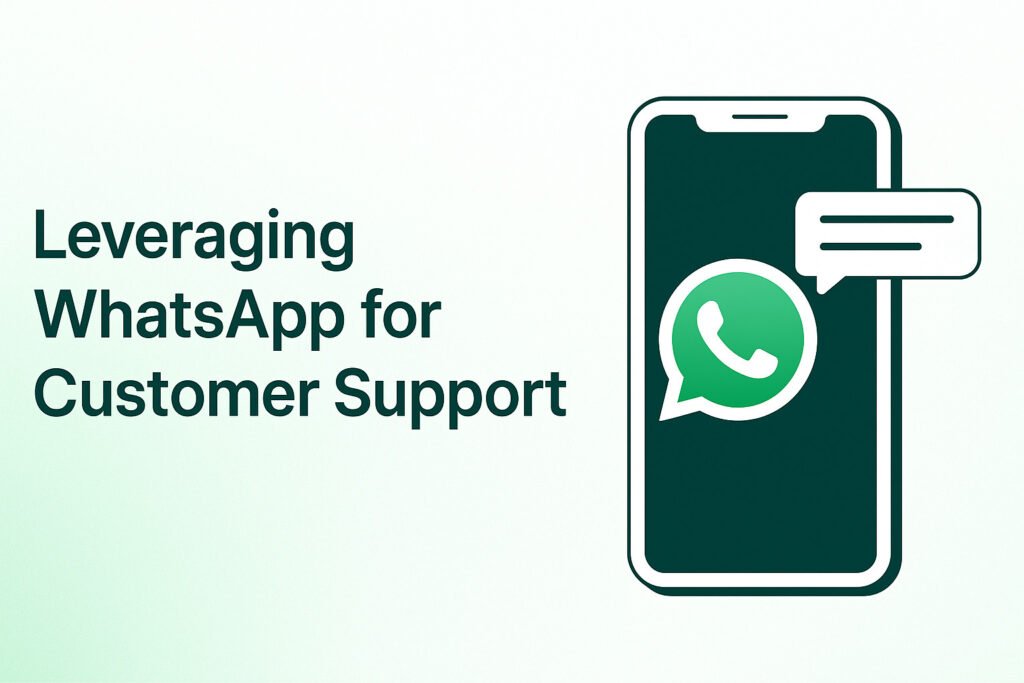
Introduction In today’s digital era, customer expectations are higher than ever. They demand instant, seamless, and personalized support delivered through the platforms they already use. WhatsApp, with its familiar interface and widespread adoption, has become one of the most effective channels for customer service. This guide explains how businesses can leverage WhatsApp for customer support, the benefits of using it, best practices, and how TheBotMode makes setup simple and scalable. 1. Why Use WhatsApp for Customer Support Changing Customer Behavior: Customers today expect convenience and real-time responses. WhatsApp provides direct access to support in an app they already use daily. AI-Powered Automation: Businesses can scale their support operations with automation and artificial intelligence, reducing costs while improving efficiency. Global Reach: With over two billion users, WhatsApp allows brands to connect with customers worldwide. 2. Key Benefits of WhatsApp Customer Support Feature Benefit Context-Rich Conversations Ongoing chats retain history, eliminating the need for repetition and enabling faster solutions. Efficient Support at Scale Automate FAQs and routine queries to free agents for complex cases. Personalized Interactions Deliver human-like and tailored responses. Trust and Security End-to-end encryption ensures customer data and privacy remain protected. Omnichannel Continuity Integrate WhatsApp with CRM, email, or helpdesk tools for smooth workflows. Proactive Engagement Send order updates, reminders, and alerts before customers ask. Multilingual Support Provide assistance in multiple languages to increase customer satisfaction. 3. How TheBotMode Simplifies WhatsApp Support No-Code Setup: Deploy WhatsApp support without technical expertise. Seamless Handoff: Bots handle FAQs while agents can take over complex queries. Analytics Dashboard: Monitor response times, resolution rates, and customer satisfaction scores. Integrations: Connect with CRMs, ecommerce systems, and ticketing platforms. 24/7 Availability: Offer round-the-clock support without scaling headcount. 5. Best Practices for WhatsApp Customer Support Be Transparent: Clearly communicate expected response times and whether customers are interacting with a bot or a human. Stay Consistent: Maintain a consistent brand voice across all customer interactions. Use Automation Wisely: Automate FAQs but provide easy escalation to live agents. Personalize Responses: Incorporate customer names, order history, and preferences into conversations. Be Proactive: Send reminders, order updates, and follow-ups to reduce support queries. 5. FAQs What information does WhatsApp collect during support? WhatsApp collects basic details such as phone number, device information, and chat logs for service continuity. Can customers complete transactions through WhatsApp? Yes. Payments can be processed using gateways like UPI, Razorpay, or credit and debit cards. What happens if a WhatsApp Business account gets blocked? Businesses can appeal directly through WhatsApp. Platforms like TheBotMode help ensure compliance to reduce such risks. How can customers find a business’s WhatsApp support channel? Businesses can promote links through their website, social media, email campaigns, or QR codes. Verified accounts may also appear in WhatsApp’s business directory. Is it possible to track support performance? Yes. Businesses can track resolution times, response speed, and customer satisfaction through analytics dashboards. Is customer privacy protected on WhatsApp? All conversations are encrypted end-to-end. TheBotMode ensures compliance with privacy regulations such as GDPR. Conclusion WhatsApp is no longer just a messaging platform. It is a robust customer support channel that enables businesses to provide faster, smarter, and more personalized service. With TheBotMode, setting up WhatsApp customer support is quick and requires no coding. Businesses can scale effortlessly with automation, integrate existing tools, and track every interaction to ensure customer satisfaction.
10 Best WhatsApp Api Providers for D2C Brands in 2025

Introduction WhatsApp has become the most powerful channel for D2C brands in India. From COD verification to abandoned cart recovery, brands rely on WhatsApp to cut RTO, increase conversions, and improve customer experience. But with so many WhatsApp companies and WhatsApp API providers available, it’s tough to know which one to choose. Should you go with a popular name like WATI or Interakt, or explore a WATI alternative better suited for D2C? How do you evaluate pricing models like AiSensy pricing compared to others? In this blog, we compare the 10 best WhatsApp Business API providers in 2025—their features, pros, cons, and pricing—so you can find the right fit for your brand. What to Look for in a WhatsApp Business API Provider Before diving into the list, here’s what every founder must consider when choosing a WhatsApp API service provider: 10 Best WhatsApp Marketing Automation Platforms for D2C Brands in 2025 1. TheBotMode (Best for D2C Growth in India) 2. WATI 3. Interakt 4. AiSensy 5. Sleekflow 6. Gupshup 7. Zoko 8. Gallabox 9. Manychat 10. Rasayel Developer-Friendly WhatsApp API Solutions For technical founders and teams, choosing the right WhatsApp API provider matters. Some WhatsApp API service providers like Gupshup, Twilio, and Vonage focus heavily on developer tools. They are ideal if you want to custom-build workflows and integrate directly into your backend systems. This is where the WhatsApp API for developers shines—giving more flexibility than plug-and-play SaaS tools. Comparison Table Platform Best For Key Features Pricing Insight Cons TheBotMode Indian D2C scaling brands COD verification, RTO reduction, AI flows ₹2,500/mo + Meta cost Focused on D2C only WATI Beginners Shared inbox, broadcasts Affordable Limited AI Interakt SMBs Catalog, order tracking Budget-friendly Weak at scale AiSensy Mid-size D2C Broadcasts, catalog AiSensy pricing markup Costly Sleekflow Omni-channel AI chatbot, CRM Premium pricing Expensive in India Gupshup Enterprise Developer APIs Custom Complex for SMBs Zoko WhatsApp shops Cart recovery Moderate Shopify only Gallabox Small teams Broadcasts Low-cost Limited features Manychat Creators IG+FB+WhatsApp bots Global Weak for e-com Rasayel B2B sales CRM handoff Premium Not D2C focused FAQs Q1. Which is the best WhatsApp API provider in India? The best WhatsApp API provider in India depends on your business type. For D2C, TheBotMode offers the most cost-efficient and AI-driven solution. For SMBs, Interakt and WATI are common choices. Q2. What are WhatsApp Business API solutions? WhatsApp Business API solutions include abandoned cart flows, COD verification, order updates, and AI-driven product recommendations that help brands scale faster. Q3. How do WhatsApp solution providers differ? Every WhatsApp solution provider offers different strengths—some focus on small businesses, others on enterprise APIs, and some like TheBotMode specialize in D2C automation. Why TheBotMode Wins for D2C Unlike generic platforms, TheBotMode is built for D2C brands in India. For founders looking for a WATI alternative or a cost-effective WhatsApp Business API provider, TheBotMode is the smarter choice. Conclusion WhatsApp is the future of D2C growth in India. With so many WhatsApp companies and WhatsApp API service providers, choosing the right partner is critical. From WATI to Interakt, AiSensy to Sleekflow—each has strengths. But if you’re serious about scaling a D2C brand in 2025, TheBotMode stands apart with AI automation, RTO reduction, and transparent pricing. 👉 Ready to unlock growth?Book a Free Demo with TheBotMode and start scaling smarter with WhatsApp today.
Next-Gen Customer Service for D2C: Real-Time Support That Drives Growth
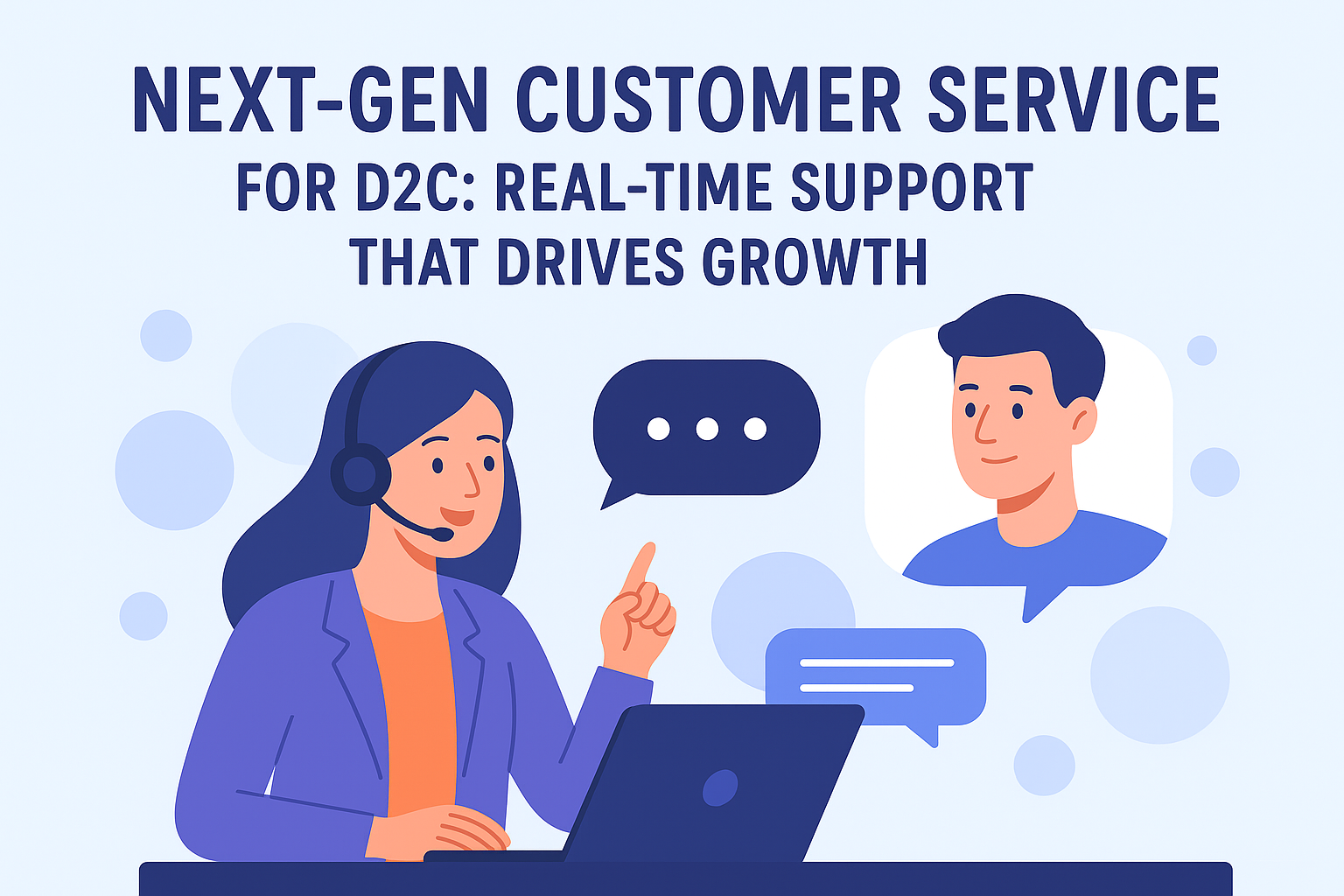
Introduction Direct-to-consumer (D2C) brands are reshaping commerce by building direct relationships with customers. But with great access comes great responsibility: today’s shoppers expect instant, personalized, and seamless support. In 2025, real-time customer service isn’t just a “nice-to-have”—it’s a growth driver that impacts loyalty, trust, and repeat purchases. Why Real-Time Support Matters for D2C Brands D2C customers no longer tolerate long wait times. Whether on a product page, checkout, or post-purchase stage, they expect immediate answers. By controlling the entire customer journey, D2C brands can tailor real-time support to maximize lifetime value and ensure customers come back. Next-Gen Real-Time Support Technologies AI-Powered Chatbots & Virtual Assistants Advanced tools like Tidio, LiveAgent, and Zendesk deliver 24/7 live chat with intelligent routing. Emerging systems such as SentiCore even detect customer sentiment, offering empathy-driven responses and reducing escalations. Agentic AI & Autonomous Support Beyond simple chatbots, agentic AI can handle complex tasks such as refunds, returns, and shipment updates dynamically, freeing human agents for high-value conversations. Hybrid Human–AI Support Models Industry leaders like Verizon are showing the power of hybrid systems—AI handles routine queries, while trained human agents resolve nuanced issues. This ensures efficiency without losing the human touch. Omnichannel & Messaging Integration From WhatsApp Business to voice assistants, real-time support across multiple touchpoints is key. D2C brands adopting unified, omnichannel experiences keep engagement consistent and frictionless. Best Practices for Implementing Real-Time Support 💡 Pro Tip: Explore advanced solutions at The Bot Mode’s customer service for D2C to implement scalable real-time support strategies. Real-World Use Cases & Impact These success stories prove that real-time service directly fuels growth and retention. Conclusion For D2C brands, real-time customer service is no longer optional—it’s a competitive edge. By combining AI, automation, and human empathy, brands can deliver instant, personalized, and scalable support that drives growth, loyalty, and trust. The future belongs to brands that see customer support not as a cost center, but as a growth engine. FAQs Q1. What defines “real-time customer support”? It means instantly resolving customer queries via live chat, messaging apps, or voice assistants without delay. Q2. How can a D2C brand balance automation and personalization? By using AI for routine tasks and human agents for complex, emotional interactions. Q3. Which channels should D2C brands prioritize for real-time support in 2025? WhatsApp, live chat, AI-powered assistants, and voice-enabled platforms.
The Psychology of Clicks: Crafting WhatsApp Buttons That Convert
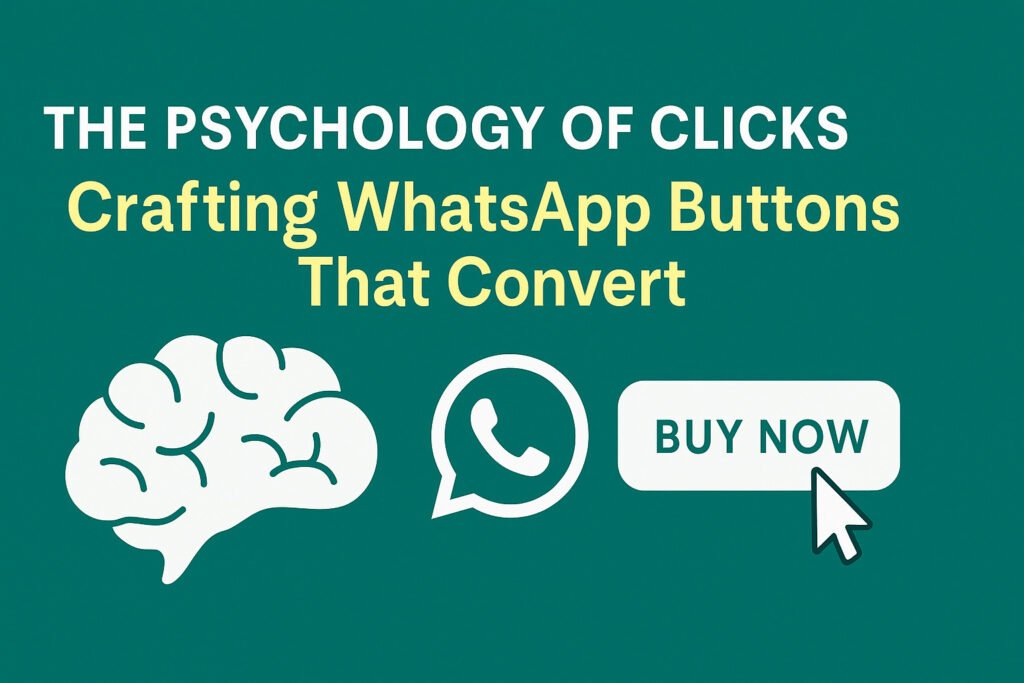
Introduction For D2C brands, every click matters. Whether it’s recovering an abandoned cart, confirming a COD order, or nudging a repeat purchase—the button your customer taps on WhatsApp can make or break the conversion. In this blog, we’ll dive deep into the psychology of clicks, and how to craft WhatsApp buttons that don’t just look good—but actually drive results. Why WhatsApp Buttons Matter for D2C Brands The Psychology Behind a Click Types of WhatsApp Buttons That Convert Why This Works for Indian D2C Brands In India, over 80% of D2C orders are COD. That’s why WhatsApp buttons like “Confirm COD” or “Pay Online & Save” are powerful in reducing Return-to-Origin (RTO) issues.Global D2C brands, on the other hand, can focus on “Track Shipment” or “Get Support” buttons that enhance customer experience post-purchase. Answering Voice & AI Queries Voice assistants and AI rely on clear, action-driven text. Buttons like “Buy Now” and “Track Order” are AEO-friendly because they directly answer queries like: Pro Tips for Crafting High-Converting WhatsApp Buttons Keep text under 20 charactersUse verbs → “Buy”, “Confirm”, “Track”Always align with user intent (pre-purchase vs post-purchase)Test 2–3 button variants and track CTR in TheBotMode analyticsPair buttons with conversational text, not robotic messages Conclusion WhatsApp isn’t just a chat app—it’s a conversion engine. For D2C brands, the right button text + psychological triggers = more sales, less RTO, and happier customers. With TheBotMode, you can design, test, and optimize WhatsApp buttons at scale, making every click count. FAQs Q1: How many buttons can I add to a WhatsApp message? You can add up to 3 quick reply buttons or 2 call-to-action buttons per message template. Q2: Do WhatsApp buttons work on all devices? Yes, buttons are supported across Android, iOS, and WhatsApp Web. Q3: How do buttons reduce COD RTOs? By asking customers to confirm orders, you eliminate fake CODs and reduce logistics costs. Q4: Can I customize buttons per customer? Yes, using personalization tags in TheBotMode, you can send dynamic button text based on name, product, or offer.
The Power of Repeat Orders: Retention Tactics That Work for D2C Brands
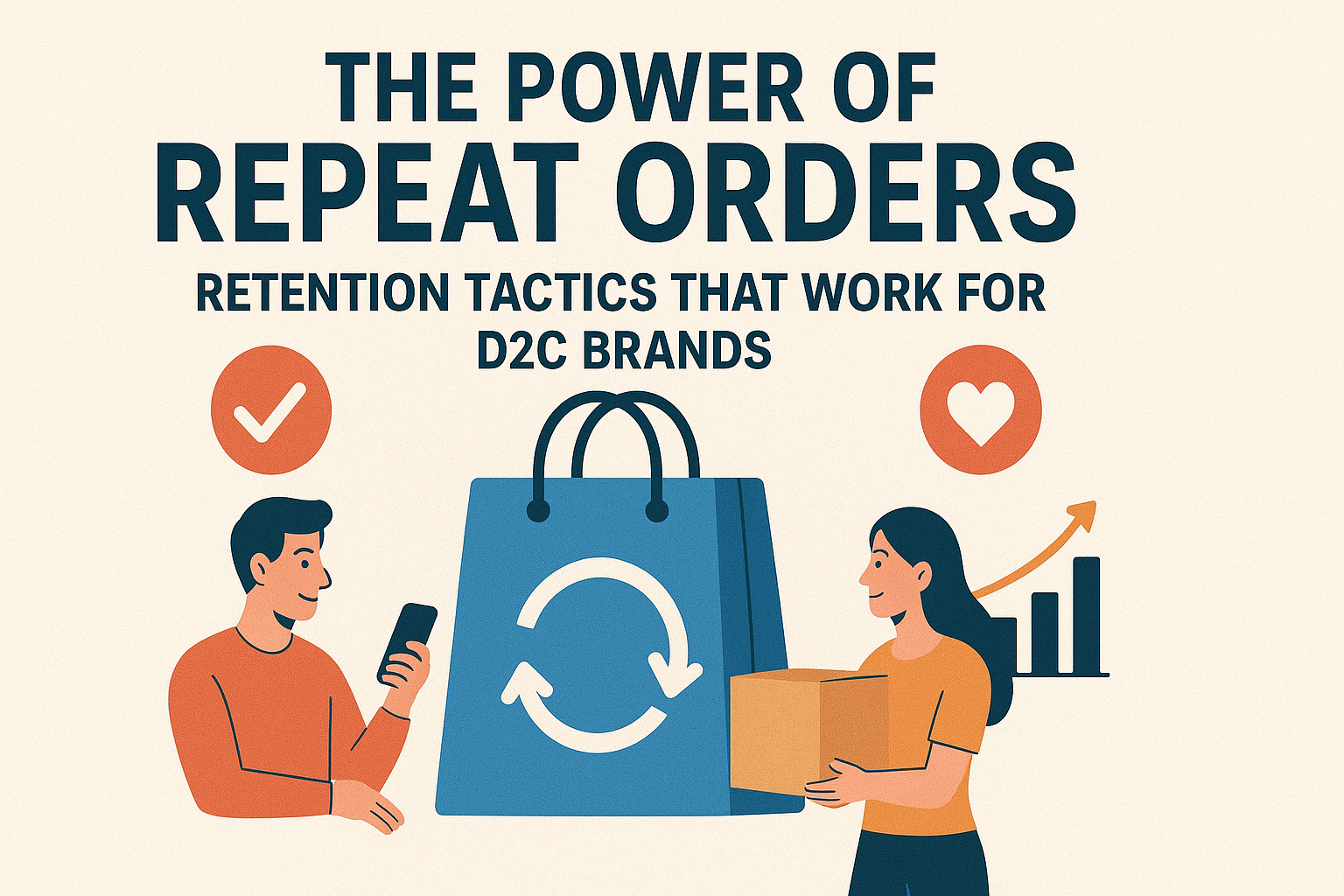
The Power of Repeat Orders for D2C Brands In the fast-evolving D2C landscape, repeat orders are the lifeblood of sustainable growth. While many brands focus heavily on acquisition, the real profitability lies in turning one-time buyers into repeat customers. Repeat orders not only reduce acquisition costs but also amplify customer lifetime value (CLV) and create strong brand advocacy. Why Repeat Orders Are Your D2C Brand’s Secret Growth Engine Customer acquisition costs (CAC) are climbing across digital platforms, making retention a smarter and more profitable growth strategy. Repeat customers spend more, convert faster, and are more likely to refer friends and family. For D2C brands, cultivating repeat orders creates a predictable revenue stream and builds long-term trust. Retention Tactics That Drive Repeat Orders Hyper-Personalization Across the Customer Journey Customers crave tailored experiences. From personalized emails to dynamic SMS campaigns, hyper-personalization can lift sales by up to 20%. Post-purchase personalization—such as product care tips or curated upsell recommendations—creates a seamless journey that keeps customers engaged and primed to return. Fast & Reliable Delivery as Emotional Loyalty Builder Speed matters. Studies show fast delivery can increase reorder likelihood by 74%, while delays risk high churn. Transparency in shipping updates and reliable fulfillment turns logistics into a loyalty driver. Loyalty & Tiered Reward Programs Tiered loyalty programs—offering points, perks, or exclusive rewards—can increase repeat purchases by 15–25%. The key is balancing transactional incentives (discounts, free shipping) with emotional rewards (exclusive content, VIP experiences). Subscription Models & Auto-Restock Reminders Subscriptions help brands build habitual buying and ensure consistent revenue. Auto-restock reminders further reduce friction by prompting one-click reorders at just the right time, minimizing cart abandonment. Post-Purchase Upsells & One-Click Reorders Smart post-purchase strategies, such as upselling on order confirmation pages or offering limited-time bundles, boost AOV (average order value). One-click reorder buttons simplify the customer journey and create stickiness. Community-Driven Engagement & Gamification Beyond transactions, today’s customers want belonging. Building communities—through user-generated content, gamified loyalty systems, or brand clubs—creates emotional bonds that keep customers coming back. Tech-Enabled Custom App Features A dedicated app elevates engagement with features like push notifications, loyalty integration, and personalized reorder experiences. It strengthens brand exclusivity and ensures customers stay in your ecosystem. Genuine Personal Touches (Human-First Tactics) Sometimes the smallest gestures create the biggest impact. Handwritten thank-you notes, surprise gifts, or personalized packaging can double customer lifetime value. These touches create authentic connections that digital automation alone can’t achieve. Conclusion Repeat orders are more than just transactions—they’re the foundation of sustainable D2C growth. By blending personalization, reliable fulfillment, loyalty programs, and emotional touches, brands can transform casual buyers into lifelong advocates. When executed well, these retention tactics not only boost revenue but also future-proof your brand against rising acquisition costs. FAQs 1. How soon should I send a post-purchase follow-up? Within 24–48 hours of delivery, focusing on value and helpfulness rather than pushing another sale immediately. 2. Should loyalty programs favor discounts or experiential rewards? A balance works best—discounts drive immediate repeat purchases, while experiences (VIP events, early access) build long-term loyalty. 3. Can smaller brands compete with Amazon in delivery speed? Yes—by focusing on transparency, niche fulfillment partners, and exceptional packaging, smaller brands can still delight customers. 4. How can I personalize at scale without compromising the human feel? Combine automation tools for segmentation with genuine human touches—like personalized notes or customer support interactions—to strike the perfect balance.
Unlock the WhatsApp Blue Tick
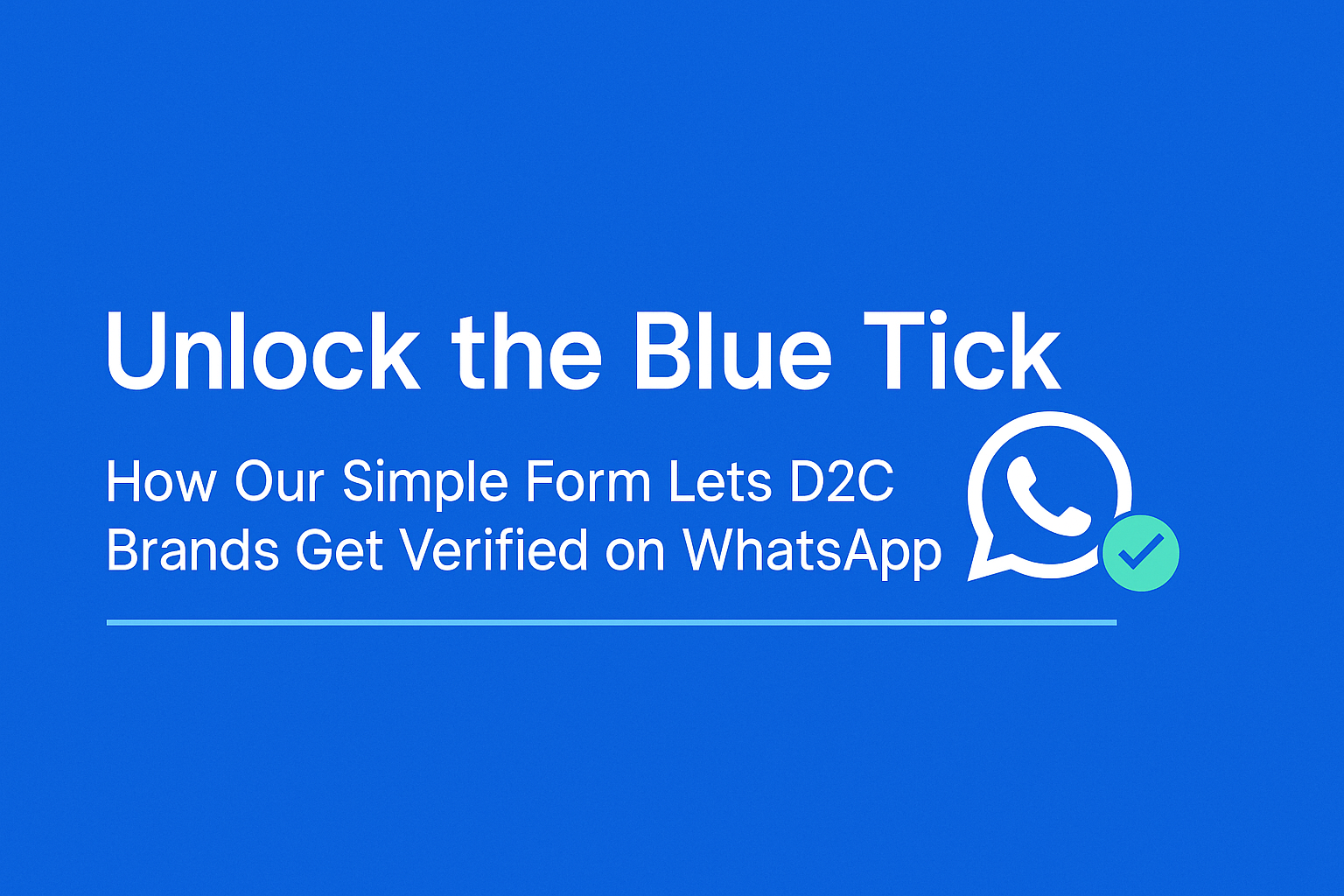
Unlock the Blue Tick: How Our Simple Form Lets D2C Brands Get Verified on WhatsApp Introduction Building trust is essential for D2C brands—and nothing communicates legitimacy more powerfully than WhatsApp’s Blue Tick verification badge. At The Botmode, we’re simplifying the process. You fill out a quick form on this landing page, and we handle the entire verification journey—from eligibility checks to submission. Let’s explore how this works, why it matters, and—most importantly—how it drives growth for your brand. Why WhatsApp Verification Matters for D2C Brands 1. Instantly Builds Credibility The WhatsApp Blue Tick is a strong trust signal—showing customers you’re authentic and official. Brands with the Blue Tick often see significantly higher open and response rates, with messages achieving close to a 98% open rate. 2. Streamlines Messaging and Campaign Performance Verified accounts tend to experience better engagement in broadcasts and chat interactions, which is key for promotions, cart recovery, and customer support. 3. Consistent Branding Across Meta Platforms By aligning your WhatsApp verification with Meta’s blue tick standards, your brand maintains a coherent and trusted presence across Instagram, Facebook, and WhatsApp. Here’s How Our Landing Page & Verification Form Work Step What You Do What We Do 1. Fill the Form Provide your business name, WhatsApp number, Meta Business Manager ID, and up to 5 credible media or PR links. We review your eligibility and documentation. 2. Submit with Confidence Click “Submit.” No need to navigate WhatsApp settings yourself. We handle API access, document prep, and application submission. 3. Sit Back and Track Progress Receive status updates via email—approved or follow-up needed. We monitor the application and guide any re-submissions (if needed). 4. That’s It! Once verified, you’ll enjoy the benefits of the Blue Tick. We’ll help you integrate verified status into your WhatsApp marketing. A simple form. Zero hassle. Full service. Eligibility: Are You a Fit? To streamline the process, here’s what qualifies your brand: Once Verified: What’s Next for Your D2C Growth Leverage the Blue Tick Promote the badge across your website, social media, and email—customers immediately recognize the legitimacy. Drive Conversational Commerce Use WhatsApp for support, abandoned cart messages, flash sales, and VIP broadcast lists—backed by higher engagement. Measure Success Track metrics like open rates, response times, and conversions in your WhatsApp Manager dashboard. Use these insights to refine your strategy and boost ROI. Conclusion Our streamlined landing page and form remove all the friction from WhatsApp verification. You focus on what you do best—growing your D2C brand—while TheBotmode handles the rest. Ready to unlock trust, boost engagement, and scale faster? Fill out the form above, and let’s get your Blue Tick verified and working for you. Voice‑Search Optimized FAQ Q: What is the WhatsApp Blue Tick? A: It’s a verification badge from WhatsApp (via Meta) that signals your business is legitimate and trustworthy. Q: How do I get verified? A: Just fill out the form right here—providing your business details and media links—and we’ll do the rest for you. Q: Is verification available for small D2C brands? A: Absolutely—any brand with an active WhatsApp Business profile and evidence of notability can apply. Q: How long does it take? A: Reviews usually take a few business days. If needed, you can reapply after 30 days post-rejection.
How WhatsApp Automation Helps D2C Brands Compete with Marketplaces
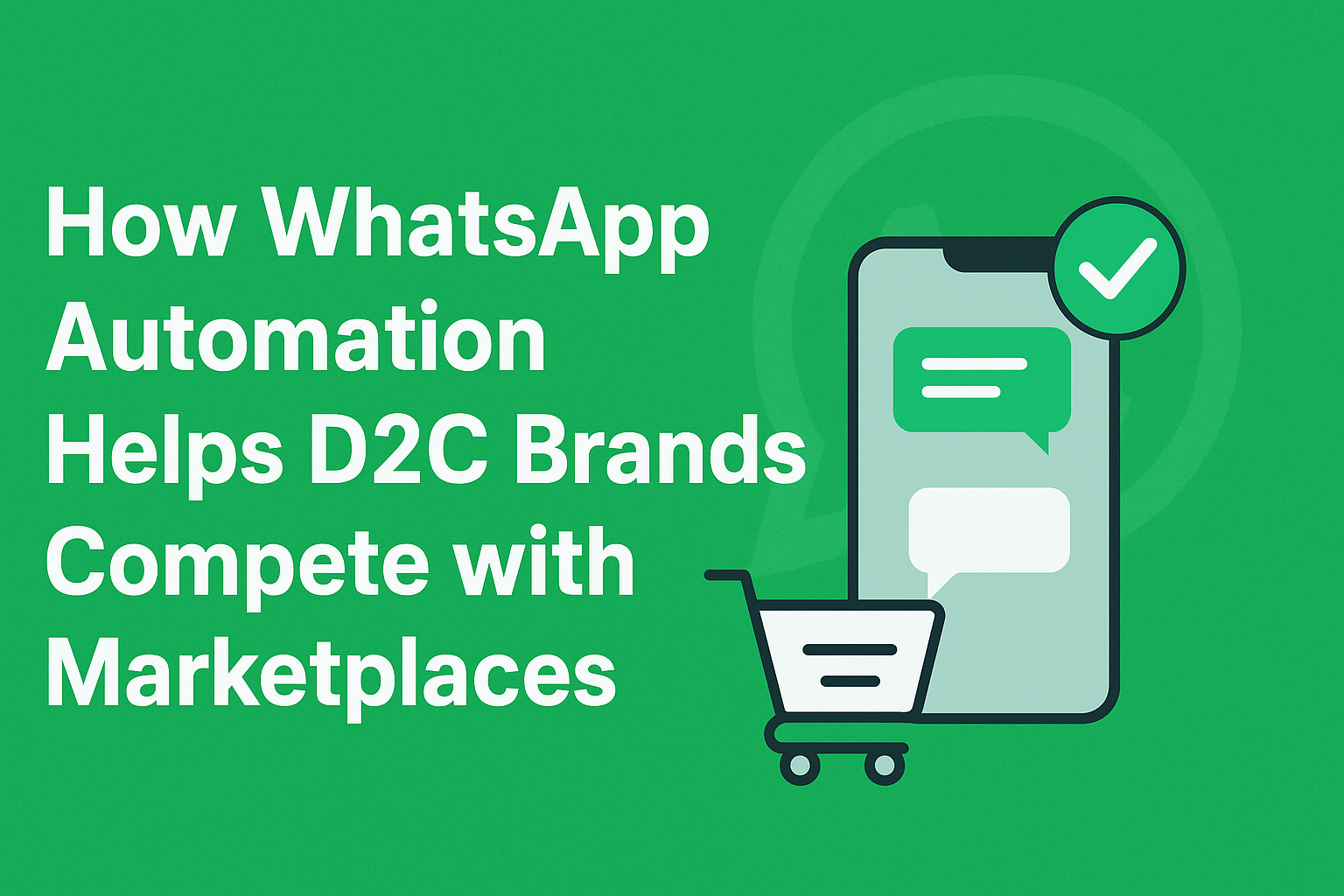
Introduction For direct-to-consumer (D2C) brands, competing with giant marketplaces like Amazon, Flipkart, or Myntra often feels like a David vs. Goliath battle. Marketplaces offer scale, convenience, and reach, while D2C brands focus on personalization, brand loyalty, and customer intimacy. This is where WhatsApp automation changes the game. By turning the world’s most popular messaging platform into a full-fledged sales, service, and marketing channel, D2C brands can engage customers directly, recover lost sales, and build loyalty—all without the high commissions and fragmented visibility of marketplaces. The WhatsApp Advantage for D2C Brands Unlike marketplaces, where your brand competes for attention, WhatsApp gives you a direct, distraction-free line to your customers. Learn more about conversational commerce solutions designed specifically for D2C growth. Key Ways WhatsApp Automation Empowers D2C Brands 1. Real-time, Automated Customer Support & Order Notifications Automated bots handle FAQs, order confirmations, delivery updates, and return requests. Customers get instant answers without waiting for agents, while brands save time and resources.👉 Explore automated WhatsApp chatbots that streamline customer service for D2C brands. 2. Cart Abandonment Recovery & Personalized Nudges With WhatsApp automation, brands can send timely reminders when customers abandon their carts. Personalized nudges—like discount codes or product recommendations—bring shoppers back to complete their purchases. 3. Conversational Campaigns & Broadcasts Instead of one-way promotions, WhatsApp allows interactive campaigns. D2C brands can send: This creates marketplace-like reach but with much higher engagement rates. Tools like The Bot Mode make it easier to manage scalable broadcasts while maintaining personalization. 4. In-Chat Shopping: Catalogs + Payments Customers can browse catalogs, add items to cart, and even pay—all within WhatsApp. This frictionless buying journey reduces drop-offs and accelerates conversions. 5. Integration with CRM & Analytics WhatsApp automation tools integrate seamlessly with CRM, Shopify, and analytics platforms. Brands can track customer behavior, segment audiences, and run data-driven campaigns, rivaling marketplace-level targeting. For seamless integrations, explore The Bot Mode’s automation suite. How This Levels the Playing Field Against Marketplaces Conclusion Marketplaces may dominate with scale, but WhatsApp automation gives D2C brands the superpower of personalization, loyalty, and direct engagement. From real-time customer support to cart recovery and in-chat shopping, it creates a marketplace-like experience—without the middleman. For D2C brands ready to scale, WhatsApp isn’t just a tool; it’s the secret weapon to compete—and win—against marketplaces. Start your journey today with The Bot Mode. FAQs Q1: What is WhatsApp automation for D2C brands? It’s the use of chatbots, templates, and automation tools on WhatsApp to handle sales, support, and marketing without manual effort. Q2: How does WhatsApp help D2C brands compete with marketplaces? It provides direct customer engagement, higher conversions, and brand loyalty while avoiding marketplace fees and competition. Q3: Can customers shop and pay directly on WhatsApp? Yes, with catalogs and integrated payment options, WhatsApp enables a complete in-app shopping journey.Q4: Is WhatsApp automation cost-effective? Yes. Compared to ads or marketplace commissions, WhatsApp automation delivers higher ROI at lower costs.
The Future of WhatsApp Commerce: AI, Chatbots, and Native Payments

Introduction WhatsApp has evolved from a messaging platform into one of the most powerful tools for eCommerce. With more than 2 billion global users, it is now enabling brands to drive product discovery, customer engagement, and complete shopping journeys. The future of WhatsApp Commerce lies in three core innovations: AI, Chatbots, and Native Payments. AI-Powered Conversations Artificial Intelligence is making WhatsApp interactions smarter and more personalized. AI transforms WhatsApp into a true digital sales assistant rather than just a broadcast medium. Chatbots Driving 24/7 Commerce Chatbots are becoming essential for handling large-scale customer interactions. They enable: This allows brands to scale service and sales while keeping costs manageable. Native Payments: The Game-Changer Meta has begun rolling out native payments within WhatsApp in India and other regions. Customers can now: For markets with high COD usage, native payments support prepaid conversions, helping brands reduce return-to-origin (RTO) rates significantly. Why This Matters for D2C Brands The Road Ahead The future of WhatsApp Commerce is about building an end-to-end ecosystem where customers can discover, interact, purchase, and pay—all inside WhatsApp. With AI, Chatbots, and Native Payments working together, D2C brands can offer unmatched convenience and personalization. Those who adopt these innovations early will gain a competitive edge in the market. FAQs Q1: What is WhatsApp Commerce? WhatsApp Commerce refers to using WhatsApp as a channel for product discovery, customer engagement, order processing, and payments. It enables complete shopping journeys within the app. Q2: How do AI chatbots help in WhatsApp Commerce? AI chatbots handle repetitive tasks such as product recommendations, order tracking, and customer support. They personalize conversations, improve engagement, and reduce manual workload. Q3: What are Native Payments in WhatsApp? Native Payments allow customers to complete transactions directly inside WhatsApp without being redirected to external websites. They can pay via UPI, cards, or integrated gateways. Q4: Why are Native Payments important for D2C brands? Native Payments reduce friction at checkout, improve conversions, and help convert COD orders into prepaid, thereby lowering return-to-origin (RTO) rates. Q5: How can small businesses benefit from WhatsApp Commerce? Small businesses can use AI-powered chatbots and native payments to scale customer service, increase sales, and compete with larger brands at a fraction of the cost. Conclusion WhatsApp is no longer just a communication platform—it is shaping the future of digital commerce. With AI, Chatbots, and Native Payments, brands can provide seamless, personalized shopping experiences. D2C businesses that embrace this transformation today will define the next era of eCommerce.













